|
|
Welcome to my travel log! You will find here a lot more than in the travel reports, stripped from political correctness. Enjoy! 
Dec 24, 2005 07:00 PM Barra - The Gambia, a crossroads village
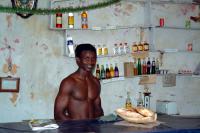 To get to the other side of the river one, and I mean everyone, needs to take a boat. There are no bridges. One has a choice though - a ferry or a small wooden canoe. I went for a ferry. The actual trip takes about half an hour or forty five minutes.
To get to the other side of the river one, and I mean everyone, needs to take a boat. There are no bridges. One has a choice though - a ferry or a small wooden canoe. I went for a ferry. The actual trip takes about half an hour or forty five minutes.
The first time I was in The Gambia, there were only two very old ferries, whose services between Banjul in the south and Barra in the north, could be gently described as erratic. The timetable or schedule of the ferry service should only be treated as indication or suggestion and definitely not something to rely on.
The second time I had a chance to use them, a third - new and slightly larger and faster one, was introduced. One would think that the situation should have improved as a result, but it really did not. The other two ferries are so old that it almost never happens that all three boats are in operation at a time.
The crossing is a nightmare. Well, not when one is crossing on foot - there is always room for two legged creature. However, to take a vehicle across is a challenge. The queues are long and it often takes several days to put a car on one of the ferries.
It is possible to jump a line, but it costs a few hundred dalasis and there are so many different people involved in the process (I mean individuals who need to share the bribe) that it is rather cumbersome.
The governments of The Gambia and Senegal entered into discussion (I mean speculation) to build a tunnel under the river. Senegal would be very interested in this project because many trucks get stuck and deliveries from Senegal’s north of the river to the south stalls for days. Other ferries along the river are too small to take a truck, so obviously it would make sense to do something about this problem.
How long the negotiations will take is a mystery and where the money for it will come from is another story.
I crossed over to Barra hoping to see my pal, who ran an Internet cafe at the very shabby Hotel Barra. He was not there, but it did not matter. My friend Mustapha, who accompanied me, took me to the fort and a few baobab trees around.
|
Dec 23, 2005 07:00 PM Bakoteh - The Gambia
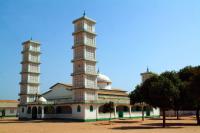 Bakoteh is a district of Serekunda's conurbation. I stayed there at my friend's. There is not much to do and see in Bakoteh. There is a nice mosque, small grocery market, and a football field, where little boys play serious games. They take bets and this is what makes the game so interesting and intense. As it was the Christmas Eve, I brought them a couple of footballs and and ball pumps, which I had gotten at the airport.
Bakoteh is a district of Serekunda's conurbation. I stayed there at my friend's. There is not much to do and see in Bakoteh. There is a nice mosque, small grocery market, and a football field, where little boys play serious games. They take bets and this is what makes the game so interesting and intense. As it was the Christmas Eve, I brought them a couple of footballs and and ball pumps, which I had gotten at the airport.
My friend and I went to the supermarket, got some funky food and some booze and made a party. Then. we went out.
|
Dec 22, 2005 07:00 PM Banjul - The Gambia, back in The Gambia again
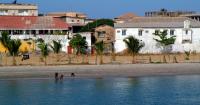 Throughout my few visits to The Gambia I developed mixed feelings about the capital city of Banjul.
Throughout my few visits to The Gambia I developed mixed feelings about the capital city of Banjul.
First, the capital did not impress me at all. I thought it was very dirty and chaotic to the extreme. I could not stand it at all. The warehouses dominating the city centre are built of concrete and crumbling down looking like they went through a number of front lines. Their architecture did not impress me either. They do not have, and never had, anything to do the colonial influence that a few books mentioned about Banjul.
It also appeared the town operated only on the market days, when people flocked to the capital to do business. In the evening the town is deserted and scary.
The second time I went to Banjul, I saw a little more of it and I did it on foot, which is the only and best way of exploring any town on this planet. I had my usual escort as well (Ernest and/or Mustapha), so I could go anywhere.
This definitely improved my impression about the town. I eventually went up the rather unattractive presidential arch and ventured into the busy market.
As I walked about the town, I discovered that there was something charming about it. It was much more civilised than the country’s main city of Serekunda. First of all it had paved streets and there was logic about how it was built.
All the streets have pavements, which is unheard of anywhere else in the country, and there is no dust. Most pedestrians keep to the sidewalks and the traffic is much less frantic.
|
Dec 19, 2005 07:00 PM Santiago de Chile - the last day
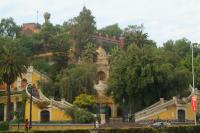 I entered one of the pedestrianised alleys, lined with shops and traders, who donned Santa’s hats. And although the passage was impossibly crowded, I preferred the difficulty of passing through the masses of shoppers to the unpredictability of the traffic.
I entered one of the pedestrianised alleys, lined with shops and traders, who donned Santa’s hats. And although the passage was impossibly crowded, I preferred the difficulty of passing through the masses of shoppers to the unpredictability of the traffic.
When I reached the Plaza de Armas, boasting a decent cathedral and an underground metro station, I faced a giant artificial Christmas tree, which looked extremely funny and... environment friendly.
Now, let me comment on two communication aspects of Santiago - yellow buses and the metro.
The fastest vehicle on Chile’s capital city’s streets is the yellow bus. The made of the buses vary and most of the buses are most definitely older than six-seven years. The key characteristic of the buses is that their drivers, usually middle-aged and slightly overweight men, are remunerated according to the number of tickets they sell on their individual vehicles. So, the first one to get to the bus stop gets all the passengers. Hence the rush. These buses would happily run pedestrians over without even noticing it! I was utterly surprised how quickly they could accelerate and how tightly a several tonnes bus filled with people can take 90 degrees corners at the speed of at least 40 mph (65 km/h) without falling on its side.
However, the drivers’ progress towards the timetable is monitored via the satellite and is reported to the drivers over the radio. So if one of the buses is running slightly late and there are no others in the close range to overtake it, then it would strategically go a little slower hoping that the number of passengers waiting on the bus stops builds up.
Santiago’s metro appears to be missing a line. It has five lines: L1 running West-East, L2 running North-South in the East, L4 running North-South in the West, L5 running diagonally North East-South West and L4A, which connects lines L2 and L4. There is no line 3. It has never been. Nevertheless, the metro is very efficient, super clean, mega safe and, above of all, scentless. It is reasonably easy to navigate and the stations are modern.
The only problem I had were the tickets, which disappeared in the machine upon entry into the station, and I felt somewhat uncomfortable without a proof that I had actually bought a ticket.
The metro system has its own television channel, which transmits highlights of world and national news and local adverts. It was great! have not seen an underground television even on the Tokyo’s metro...
|
Dec 18, 2005 07:00 PM Rapa Nui - Orongo on the last day
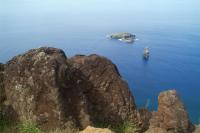 For some reason I did not visit Orongo when I was up at Rano Kau and I had to come back up there on my last day, after I already checked in for my return flight. I realised what a mistake I would have made had I not gone there at all. Orongo is one the most important sites on Rapa Nui. It was the site of the Birdman tradition, a cult which was key to the evolution of the Rapanui society.
For some reason I did not visit Orongo when I was up at Rano Kau and I had to come back up there on my last day, after I already checked in for my return flight. I realised what a mistake I would have made had I not gone there at all. Orongo is one the most important sites on Rapa Nui. It was the site of the Birdman tradition, a cult which was key to the evolution of the Rapanui society.
The cult of the Birdman was still in place when the Europeans arrived on the island. The origins of the cult were connected to the shortage of natural resources, which followed the deforestation. A just distribution of the resources was a challenge and hence the islanders thought of a competition, based on which they would nominate a leader who would oversee the allocation of provisions, etc. amongst the clans.
Every year, each clan nominated a representative, who swam from Orongo, a sacred-made place near Rano Kau, to the nearby islets of Motu Nui to collect the first egg laid by sooty tern. A swimmer to return first with the egg secured his clan's leadership on the island for the year.
There are many stone carvings at Orongo, that depict the cult - see picture above showing the image of the Birdman.
Orongo eventually became a village. I found the site very exciting. I love those kind of ancient places. The Orongo houses were narrow and small, but their position by Rano Kau was spectacular, and the ocean views were superb.
After the arrival of the Europeans, the tradition diminished since increasingly more supplies kept arriving with the visitors, and ironically, Rapa Nui turned from self-sufficient (although struggling) to dependent on supplies from across the ocean. Subsequently, the Birdman cult stopped. Obviously, there was little need to continue with the competition, but it was a great tradition.
I was wondering why it has never been revived if only for sports or recreation purposes. This is what I thought before I came to Orongo. When I looked down from the site on to the ocean waters, I realised that one would actually risk their live to jump from the crater's edge into the ocean. The crater rises some 250 meters above the sea level and it more than obvious that jumping was not a joke.
Incidentally, locals told me that there had been talks to bring some reminiscence of the Birdman tradition in the form of stunt event performed by professionals. I am not sure if they would attempt jumping from the top of Orongo, or slightly lower, but it would be a great event in a great place.
There are many traditions of Rapa Nui which had not been written down and were only passed to young generations verbally. There is a risk that in the result of youth's lesser interest in the traditional way of living the Rapanui culture might die without being properly recorded.
For example, one night I went to see the traditional Rapanui dance, which clearly demonstrated that the island was part of Polynesia. The gals and guys put up a great show and were fluent in it. The guys were showing off their traditional tattoos, which also proved that the Rapanui people were Polynesian. However, I later found out that the numerous motorbikes, which were the only source of noise on the island, belonged to those dancers! It was clear that the live moves on and unless the clinging to certain traditions provides some income (that show was expensive - clearly! - so were the motorbikes), the youth will abandon them in no time.
|
Dec 18, 2005 07:00 PM Rapa Nui - Rano Kau
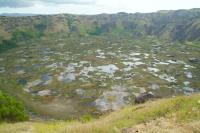 After breakfast, I decided to walk up the volcano of Rano Kau. Unfortunately I shared the idea with the hotel owner, who became worried that I was not going to make it because it as too far and too hot. Then, I chose not to share my thought that I was going to totally ignore his comments.
After breakfast, I decided to walk up the volcano of Rano Kau. Unfortunately I shared the idea with the hotel owner, who became worried that I was not going to make it because it as too far and too hot. Then, I chose not to share my thought that I was going to totally ignore his comments.
The hike was great. I decided to take the road on the way up and the trail on the way down. The road was steadily and almost evenly ascending. There were not flat parts at all. I liked that because I could keep my rhythm. Part of the road was in the shade, which was a blessing as my contact lenses were filled with sweat most of the time, and I was not longer sure if I was tired or just could not see sharp anymore.
Had I not sweated that much, I might have been more sure if one of the people I met on the road was the actor, who played in the film ‘Shakespeare In Love’ the role of the actor with the stutter.
The awesome crater of Rano Kau (picture below) impressed me! I have always had a soft spot for volcanoes. This one was one of the most regular craters I have seen, which stimulated imagination about the mighty power this Earth's zit once had.
It was almost perfectly round and the slopes were very steep, which proved that when this volcano had erupted, the Earth must have shaken considerably.
The top of the volcano was nicely maintained. There were a few information boards and even a trail at the ridge of the crater. Unfortunately, the spots, with best views were off limits.
On the way back down to the town, I met a few pieces of cattle. Unfortunately they were all adult bulls. As I as they spotted me, they stood up and watched my every single move. I am officially not afraid of cattle, but this one I did not know. I was not sure if it was savage or domesticated. And I was not sure if I wanted to die on that day.
I took a slight detour, maybe fifty yards, and even still, the bulls were looking at my rear quite unfriendly.
|
Dec 17, 2005 07:00 PM Rapa Nui - Ahu Akiwi
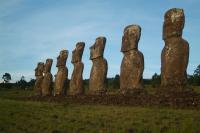 I was rather confused about this temple. It was said to be the only one with moai facing the ocean yet there were a few right at the eastern shore looking straight into water! Obviously, there a few dreadful restoration mistakes must have been made. Yet, Ahu Akivi remained controversial.
I was rather confused about this temple. It was said to be the only one with moai facing the ocean yet there were a few right at the eastern shore looking straight into water! Obviously, there a few dreadful restoration mistakes must have been made. Yet, Ahu Akivi remained controversial.
The moai at this temple do appear to be facing the ocean, however I read that they were also facing a village, which once stood at their feet. Nevertheless a few stories appear to had been invented that claimed to explain why would those moai be facing the ocean and not a village.
The seven statues at Ahu Akivi looked nicely straight into setting sun when I eventually came there, it was indeed my desired destination after visiting Ahu Tahai. I also liked the fact that they stood back to the Rano Aroi, the tallest of Rapa Nui’s three volcanoes.
After having seen almost an entire island, Ahu Akivi did not throw me on my knees. None of the moai had a pukao and their faces were washed down or weathered by erosion. They also looked so grey and sad, compared with all other standing moai. Apart from the background, their location was not great either. They were standing in the middle of nowhere. In the field! Other temples were situated at a cliff or at a beach.
Furthermore, and this is had little to do with the actual shrine, a few horrible clouds came and ruined my light. I had to linger a little longer at the ahu to catch better light. I did not like that because there were more spectacular ahus where I wanted to stay longer, but had to rush a little. Ahu Akivi was one of the reason why I was in a hurry. I was told it looked at its best at sunset.
So, when I did not find it equally attractive, I obviously was a little annoyed.
Still, I was there waiting for the sun to come out a little, and risking that I might miss the actual sunset at most important site - Tahai.
|
Dec 17, 2005 07:00 PM Rapa Nui - Rano Raraku
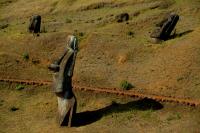 My next stop was the extinct volcano Rano Raraku, which quickly became my definitely most favourite place on Rapa Nui. This volcano was the very place where almost all moai had been carved.
My next stop was the extinct volcano Rano Raraku, which quickly became my definitely most favourite place on Rapa Nui. This volcano was the very place where almost all moai had been carved.
It was a hyper-magical place with over four hundred statues scattered almost randomly around and many in various stages of carving. Some of them were of gargantuan proportions. I loved the most those that stood tilted slightly at the volcano's foothill. This picture, this view of Rapa Nui, had been haunting me for years making me to come and visit this mysterious island ever more.
I do not know why, but the beautifully restored ahus did not make as much impact on me that Rano Raraku did. The moai at the volcano stood there gazing at different directions wondering why they never made it to a temple.
The legend, which claims that the moai had been moved by superpowers of the shamans of the villages kept jumping into my mind. It did look like that moai had been 'walking' short distances from the places they had been carved out of the volcano but then suddenly stopped. Almost like they wanted to demonstrate their disapproval for the inter-village conflicts.
The entire area was surreal, like from an aliens film. And the beauty of it was that one could wander around the statues freely, examine them by sight, touch, smell. Whatever that would thrill anyone or not. This was so contrary to the restored ahus, which had to be admired from a distance, depending on the size of the platform, and hence did not make such a powerful impact.
When I went to Rano Raraku, the sun started giving long-ish shadows placing warm colours on the moai's faces. I was so genuinely impressed with the place that I could camp there for a week between the giant stone sculptures. I was coming and going, visiting the individual moai several times. I was running back and forward like a cat with ill bladder.
From one point I loved the moai for being so large and majestic, and at the other I regretted that they were too big to be hugged. Maybe I was not running like a cat but like Byron.
Yet Rano Raraku was a volcano, whose crater can be visited and it was impressive in its own right. The easy five minutes hike to the top of the crater's ridge rewarded with two views - one of the lake in the crater and other to the magnificent Ahu Tongariki at the island's eastern shore.
Ignacio, who personally took me to the top of Rano Raraku, had fear of heights and reminded me on several occasions to be aware of strong wind currents which climb the eastern slope of the volcano.
For some reason, at the top of the crater’s ridge there were a few whole drilled to accommodate something. they large enough to accommodate me. Ignacio instructed me to enter one of them, so he was sure the wind would not blow me off the volcano.
And did I mention that for a longer while, about an hour actually, Ignacio and I were the only alive souls at the sight? I loved that. I practically had it to myself.
|
Dec 16, 2005 07:00 PM Rapa Nui - Hangaroa
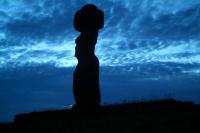 The capital of Rapa Nui, Hanga Roa, is in fact the only town on the island, where almost all inhabitants live. It is very small and has only two main streets and they switch names depending on which one of them is considered more main than the other, at a certain point in time.
The capital of Rapa Nui, Hanga Roa, is in fact the only town on the island, where almost all inhabitants live. It is very small and has only two main streets and they switch names depending on which one of them is considered more main than the other, at a certain point in time.
I stayed at the Orongo Hotel owned by a gay Rapanui. He behaved like a real drama queen or, in other words, old woman. His features were unmistakably Polynesian, and his gayness was hyper-obvious. He was always wearing a sarong made of silk with large flowers pattern, had long grey hair, which he decorated with small fresh orchid. He actually reminded me of one of my senior managers from a company, which I left shortly before travelling to Rapa Nui. I did not think it was funny at all.
Well, the hotel offered very comfortable rooms with specific features. In my bathroom I had a choice of pink towels or shocking pink towels and my bed sheets had a pattern of large pink flowers. It was very clean and the shower curtain had pink ribbons sewn on it. The rooms were spacious, had large ceiling-to-floor slide window and a round table right at it.
Shortly after checking in, I went to see the moai near the capital town. I could not wait to explore the island, visiting of which had been my dream for a long, long time. I felt I was in paradise. Literally!
(By the way, I was lucky to pay for my flight from Santiago just USD 400. I met people, some of them were Russian, who told me that they paid more than twice that!)
There were a few restored temples (ahus in Rapanui - the local language, a version of Eastern Polynesian) right in the capital, within a few minutes walk from the main streets, so I thought I could start with them and see how things develop later on. These temples were: Ahu Riata, Ahu Tautira, Vai Uri, Tahai and Ko-Te-Riku.
When I got to the first one - Ahu Riata - I could hardly believe I was there, at the end of the world! It felt a little scary that the nearest land was three hours away by air, apart from the one, which was the bottom of the ocean.
The next two sanctuaries did not make an enormous impact on me since the statues were either small or badly disfigured. However the third one, Ahu Tahai, did strike me.
It was positioned on the edge of a cliff and had five medium moai of Ahu Vai Uri in a various state of preservation in the background. It looked great with the dramatic backdrop of the ocean and cloudy sky. Particularly at sunset. I took a great number of pictures there - see one above.
I sat there in the front of it and let the wind brush my face. The sun was directly above me and the statues were shadowless. I knew I could come back there many times, because of its proximity, and yet and I thought I could soak the atmosphere a little longer. I contemplated the view and marvelled at this mystery.
I also loved the fact that I was the only visitor at the shrines. I was not sure why. I landed with two hundred other people that early afternoon and I was sure that there were others already on the island. Where were they?
Anyway, then, the Ahu Ko-Te-Riku, right next to Ahu Tahai, was a shrine with a sole large moai but complete with the pukao and large white eyes. Its face was fascinating. It showed no emotions, and expressed perhaps only calmness and consistency, like a faithful guardian.
It was a true image of Rapa Nui and, again, it looked incredible at sunset as it stood tall at the black cliff. I took a substantial number of pictures of it then and at various times of a day later on, and even in the moonlight.
Then, I decided to hike to Ahu Akivi in the centre of the island. I thought I needed to exercise and it was only a couple of hours of walking away. It was a good idea but I could not find the way. There were few signs around Rapa Nui, and all of them were at the other side of the island, of course.
As I was trying to figure out where I could have been at that time by reading a very poor map, a taxi driver stopped and asked me where I was heading. When I told him about Ahu Akivi, he obviously said it was very far. Since the island is just 17 kilometres by 24 kilometres, nowhere is really very far. So, with an obvious scepticism I said that given the size of the island it could not possibly be very far. He smiled and said he would give me a free ride to the right crossroads.
He, Ignacio, was a slim dark-haired Chilean young guy with dark eyes and pleasant smile. He was neatly dressed and was professionally polite, and to the point.
We had a quick chat about the various attractions, and you know what?, I offered him to take me to all of the key places. But he had to take me straight away! Ignacio turned his car around to top up the tank and by 4.30 p.m. I was on my fully personalised tour around Rapa Nui. What I did not know was that at the same time I was creating a domestic crisis as Ignacio was unexpectedly skipping lunch, for which he was already late anyway.
|
Dec 15, 2005 07:00 PM Valparaiso (Chile)
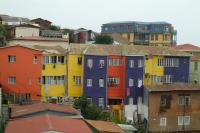 Valparaíso, located at the Pacific coast, directly west of Santiago, is a great place to exercise. The city is situated on steep cliffs, which are in fact the foothills of the Andes.
Valparaíso, located at the Pacific coast, directly west of Santiago, is a great place to exercise. The city is situated on steep cliffs, which are in fact the foothills of the Andes.
I decided to make a short, one day trip to Valparaíso, because I heard it was nice. I will come to that in a moment. So, I found out how to get there from Santiago, took the metro to the bus station and at about 11 am, I was already on the coast.
Walking around the street at lunch time was an experience for the eyes (bright colourful houses), feet (many hills - cerros - to conquer) and nose - home cooking varied - evidenced by smells of delicious garlic sauce or burnt meat.
Valparaíso was inscribed by UNESCO as a Cultural Heritage Site however I did not find the city that exceptionally pretty. There were many modern unsophisticated, grey concrete structures all over, which were rather ugly and absolutely not unique. The older buildings at the many hills were in fact photogenic only because they were painted in vivid colours, otherwise there was absolutely nothing special about them at all. I thought UNESCO would only inscribe sights, which are of exceptional beauty, cultural significance, unique, priceless and irreplaceable. I was struggling to apply any of those to Valparaíso.
The only special feature of the city were fifteen street ascensores (lifts) - funicular railways - designed to carry passengers and their shopping up and down the steep city hills. These ascensores built between 1883 and 1914 however special were not unique. Many of those can be found also in Lisbon, Portugal. Yet, UNESCO did not include Lisbon on the World Heritage List, but only one of its towers and a monastery.
I went up on two of the lifts and was amazed that they still worked. It was not exactly scary to travel on them, but it was thrilling, I might say. As it was moving very slowly, the entire wooden structure of the lift (the box) shook violently and the wheels made terrific screeching noise on the rails. There were absolutely no signs of any maintenance and they looked as old as they really were. Actually, one of the lifts is on the photograph on the previous page.
I cannot blame the authorities to keep them running. The hills are positively very steep and the poorer public with no cars would go totally mental should those lifts were taken away from them.
The lifts varied one from another and were designed to carry from four to seven passengers. The rides on them were not free of charge and they left only if they were at least sixty percent full. In the past, the fee of going up was higher than of going down. I do not think this was the case anymore when I visited, but I could see two [the same] prices quoted.
I kept wandering about the city’s hills trying to find the views, which looked pretty on postcards.
I was successful to find most of the spots that would position myself to see the views featured on the postcards and the little city guide, which I bought at the bus stop in Santiago. Nevertheless, I thought the pictures on the post cards and in the guidebook must have been doctored, because I just could not see the views in the same way.
Yes, I am willing to admit that weather, torturing me with grey skies, unpredictable mist and light showers, might have impaired my perception. The morning and the early afternoon were very dull. It felt like it was autumn and not the beginning of summer.
At about 12.30 p.m., I came across a little French restaurant called ‘Montpellier’. When I looked inside, it felt like it was meticulously kept in the French style. Small tables with dark-coloured table cloths, fragile chairs and French photographs on the walls. It was dark inside and not a single soul, apart from bored looking male.
I thought it was about time to eat, but I could not find it thrilling enough to be a sole customer there. However, being an adventurous one, I decided to risk it and came inside. As soon as I ordered my fish, a local couple entered the venue and greeted the waiter. They obviously knew each other. And I was extremely happy to see them, too. I was almost shitting myself and I did not fancy visiting the toilet twice, before and after lunch.
By the time I had my dish, which was about seven minutes after I placed my order, the restaurant was packed and there were people waiting for tables. I shoved down my fish quickly and asked for the bill. The man was surprised with my speed (that would indicate he could have been French) and I said that I cared about the business and the people waiting for tables. He laughed with gratitude on his face.
When I was leaving the place, no-one else had been served yet, by the way. And no, I did not have attend a toilet until much later in the evening, and even then I produced a regular, firm piece, which Dr JH Kellogg would not be ashamed of and perhaps might even describe it as hard like a rock and smelling like a chocolate bar. Let me stop there before I get more descriptive.
|
Page:
 74 75 76 77 78 79 80 81 82 83 84
74 75 76 77 78 79 80 81 82 83 84

|
|
|
